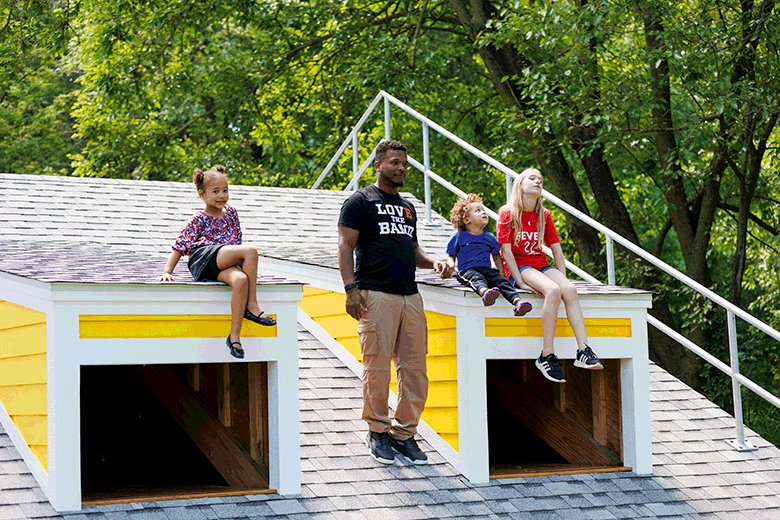Heather Hart’s Oracle of Intimation (2023) works as seating, a stage and a giant amplifier for park-goers
Photo © Anna Tiplick
“Good art allows space for viewers to see themselves in the work,” says Heather Hart, an artist based in Brooklyn, as she sits atop Oracle of Intimation (2023), her recent commission for the Virginia B. Fairbanks Art and Nature Park at Newfields. Her piece, one of three works newly installed in the park thanks to a $3m gift from the local patron and biopharma executive Kent Hawryluk to support outdoor art, consists of a house’s pitched roof lying directly on the ground, as if the rest of the home had been swallowed by the earth.
“The roof is this in-between space,” Hart says. “I want people to claim it as their own.” To that end, she has equipped the work’s attic-like interior with cables that allow park-goers to plug in their phones and play music through embedded speakers, turning the entire structure into a giant amplifier.
“It’s hard to get people to stop and slow down like that in front of a painting,” Hart says. “How do I arrest people long enough to have a somatic experience with my work that they might reflect on and think about later?” As if to answer her question, within hours of the work being unveiled in early June, two musicians were playing their guitars on the rooftop, accompanied by a drumbeat streamed through the speakers below.
Anila Quayyum Agha, This is NOT a Refuge, 2018 Photo © Anna Tiplick
All three of the newly installed outdoor works at Newfields have sonic features of one kind or another that reward time spent in reflection. This is NOT a Refuge (2018), a white, laser-etched steel structure in the shape of a house, was created by the Pakistan-born and Indianapolis-based artist Anila Quayyum Agha. Its ornate floral pattern is based on the carved walnut bookrest Agha’s mother used when reading her Qur’an. Inside the structure, a wooden bench conceals speakers that play recordings of interviews with more than a dozen refugees and immigrants living in Indianapolis discussing their experiences of dislocation and renewal.
“As an immigrant, you always have a sense of loss,” Agha says. “I try to make work that can invite people in and maybe inspire deeper connections.”
For their collaborative piece, the New York-based artists Dana Sherwood and Mark Dion (partners in life and, sometimes, art) are encouraging connections with nature. Their installation, The Pollinator Pavilion (2020), consists of a structure resembling a Victorian gazebo that has been outfitted with hanging plants, hummingbird feeders and other features intended to attract wildlife.
Mark Dion and Dana Sherwood, The Pollinator Pavilion, 2020 Photo © Anna Tiplick
It is something Sherwood has done by different means in many of her videos, which often involve staging elaborate meals with towering cakes of meat, then filming as wild animals come and gorge on the food. “We’re offering a kind of feast in a different form,” she says. The pavilion also includes paintings by Sherwood and an ornate pink sofa for human visitors. Dion adds: “We created a situation where you can have chance encounters with nature.”
Collaborating with the Newfields horticultural team—led by Lisa Milton, the director of natural resources, and Jonathan Wright, the director of the garden and Fairbanks Park—Dion and Sherwood surrounded their pavilion with native pollinating flowers so that the structure is perennially buzzing with bird and insect activity. The artists see their verdant gesture as a small corrective to the many threats facing birds and insects, from climate change and habitat loss to pesticide use. “There’s not a lot of good news coming from the insect world,” Dion says.
Mark Dion and Dana Sherwood, The Pollinator Pavilion, 2020 Photo © Anna Tiplick
These three works—collectively organised into an exhibition titled Home Again, after the structures’ domestic forms, and curated by Lisa Freiman—will be maintained and conserved as needed thanks to Hawryluk. His support will also ensure that other works that have been in the park since it opened to the public in 2010 will also be maintained, and along with future commissions and installations.
“Thanks to Kent Hawryluk’s support, projects in Fairbanks Park will have a flexible cadence going forward,” Wright says. “Maybe one big project every three years, or maybe a smaller, more ephemeral project every year, plus maintenance of existing works.”

